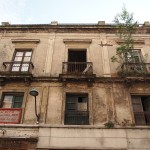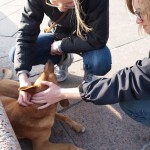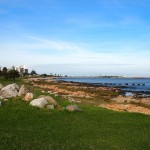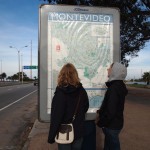In Spanish, the word for cowboy — a man who lives on an Estancia (a ranch or cattle farm) — is gaucho. And in order to experience the gaucho lifestyle, we decided to check out life on an estancia for a few days.
Alison and her sister had mentioned that staying on an estancia was a common thing for South American travelers, but that they were pricey to stay on for several nights, or often required boarders to work long hours during the day, so we were talking about the possibility of going horseback riding for just a few hours on an estancia instead. When I went to look at Colonia del Sacramento hostels and I sorted HostelWorld by most highly rated, I stumbled upon El Galope — an incredible sounding ranch in the same county as Colonia, just an hour east, two hours west of Montevideo. They had incredible ratings on several sights and were very, very reasonably priced considering the other options, so we decided to commit to one night there, and one night in Colonia.
Once we arrived at El Galope on Sunday morning, we were instantly infatuated. First of all, as much as I love city travel and exploration, it’s stressful. There’s so much to do and see,, you can really stress yourself out trying to jam pack it all in. You want to see everything, plan it all out and get directions, which is just… a lot. Not to mention cities are pricey, and our wallets were feeling a bit empty from 11 days of eating out two meals a day. We were all so happy to be out in the middle of nowhere with gorgeous, smog-free skies and chirping birds, not to mention the adorable german shepherd, 3 cute cats (a lot coming from me), and 5 gorgeous horses that belonged to the estancia owners, Monica and Miguel.
The day we arrived we spent a bit of time exploring the property, then rented 3 bikes to ride down the road a few kilometers to a goat farm, where we were hoping to purchase some goat cheese. The bikes weren’t exactly in great condition, and the road was both very bumpy and hilly, so the ride was a bit of a struggle. It was my first time on a bike in probably a decade, and sans one accidental instance of almost hitting a tree, I was able to manage riding, which is a good thing, especially considering I am mountain biking on my Machu Picchu trek!
Unfortunately, Victoria was nowhere to be found at Victoria’s goat farm, but 7 stray dogs which she has taken in greeted us at the farm, barking and begging for attention. A soft spot for puppies had developed in all of us, so we made friends and hung out with the dogs and checked out the goats before making our way back to El Galope.
We relaxed for a few hours, read and had some downtime and then had an incredible dinner of cheese fondue and tomato and rice salad. The colony of Colonia was settled by the Swiss, German and Italian immigrants of the 1800’s, and Colonia is a famous cheese producing area. The cheese in our fondue was made at farms in the immediate area, just a few kilometers from where we sat. Delicious! We also had homemade merlot, made by a neighbor whose hobby is making wine, but who only bottles wine for his friends, and El Galope is lucky enough to get a few bottles a month from him. We had some truly incredible dinner conversation with Miguel and Monica — they are both from Uruguay but moved around and lived abroad for nearly 15 years, in Davis, California, Buffalo, New York, and then in a southern city in Germany. They speak English, Spanish and German, and their children are 17 and 18, and live in Montevideo, where the two of them live part time as well. We talked about American and Uruguayan politics, about the South American dictatorships, about their experiences living abroad, their children, and even the amazing 77-year old president of Uruguay.
Their farm was so picturesque — the animals were beautiful, the land was gorgeous, and even though winter approaching meant it was bone-chilling cold, we decided to spend a second night on the farm and head out to Colonia first thing in the morning on Tuesday. We just couldn’t resist!
The next day was cloudy and rainy on and off, so we weren’t able to go horseback riding like we had initially planned. It was great to sleep in though and spend the day relaxing — Monica drove us into town, which was 6 miles from the farm and much, much bigger than we expected. We wandered, bought some groceries to cook ourselves a veggie egg scramble for lunch, and then she drove us back. After lunch, we decided to brave the very cold, windy, and overcast weather and take a walk, so we wandered down a nature trail for several hours — checked out some beautiful birds and a great pig farm — before we decided it was time to snuggle up by the fireplace and relax. After another delicious homemade dinner of local, Uruguayan white fish, we had a bottle of wine and spent several hours chatting with the other guests, an Irish couple who had been traveling in South America for nearly 3 months, and were on the last leg of their trip. They had been to so many incredible places in SA — it made me want to spend even more time traveling.
South America has become a place that I absolutely see myself coming back to — I want to see the salt flats of Bolivia, go down to Patagonia in both Chile and Argentina, and see more of Northern Uruguay and Northern Argentina, including Cordoba and Salta, not to mention all of Brazil. So many places to see! Luckily, the ridiculous visa fees I payed in Chile and Argentina, and will soon pay in Bolivia, cover my entrance to the countries for the next 10 years — I think a very reasonable personal goal to get back down here and do some more exploring!
Because of the crappy weather (and our desperate desire to horseback ride) we decided to postpone heading to Colonia a few hours so we could get up early the next day and take the horses out. I’m glad we did, because the ride was a ton of fun, but we ended up only having 3 or so hours in Colonia before the sun went down, which was a little disappointing.
Colonia is such a picturesque, incredible little town, which was built in the later part of the 18th century. The stores have adorable trinkets, the cobblestone streets are beautiful, and the sunsets over the beach take your breath away. Thankfully, Colonia is easily accessible and a much better (warmer) place to visit in the summer, so it will go on my very long list of places to come back to!
From Colonia, we took a Buquebus ferry back over to Buenos Aires, then hopped in a cab to our wonderful B&B. We were all set to head out to dinner at the incredible taco place Alison and I found in the first two days, but crisis mode set in when Carolyn read a recent review of our Iguazu hostel that mentioned bed bugs.
With serious disgust, we decided to bite the $15.50 deposit we had paid for the 3 beds/3 nights in Iguazu at the bed bug hostel and find a new place to stay. Several hours of research later, we found a good sounding place to stay, though it was a few kilometers out of the downtown area, it had really great reviews. We decided to risk the distance from the main town, and at 2 AM, we put in a reservation for one night so we could evaluate when we got there. Then, we finally climbed into bed for a few hours of sleep before our 6:30 AM alarm.
Overall, our 5 days in Uruguay were truly incredible — I didn’t quite know what to expect when we got on our first ferry, but the country is so beautiful and filled with so many sweet, truly helpful people, I’m really glad I was able to spend time there.









